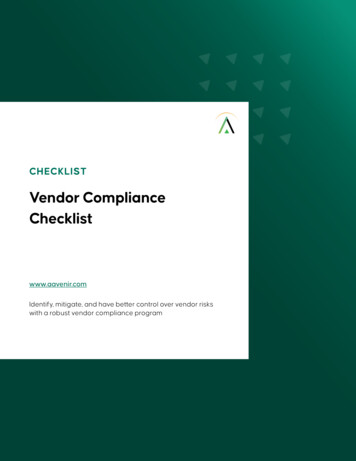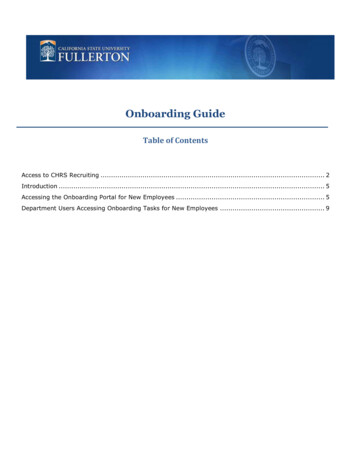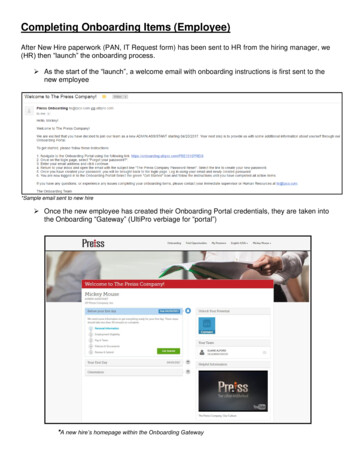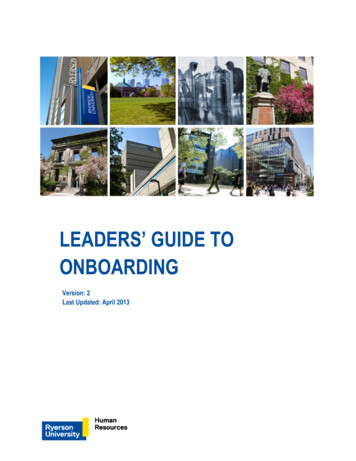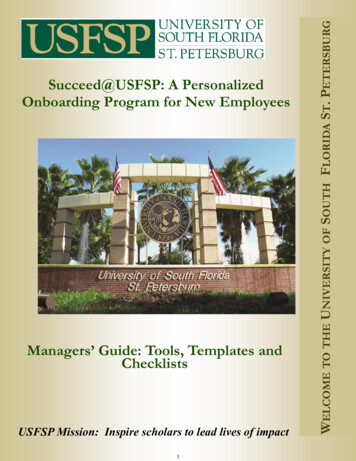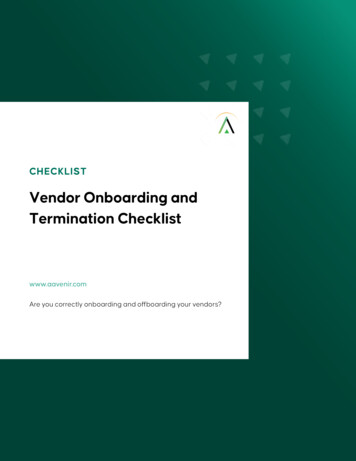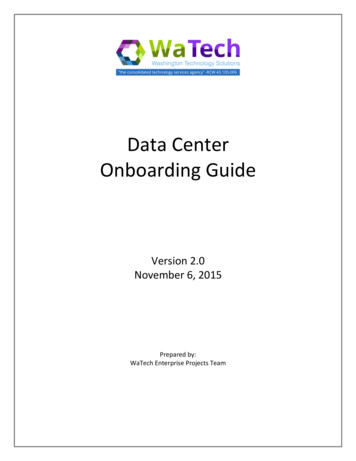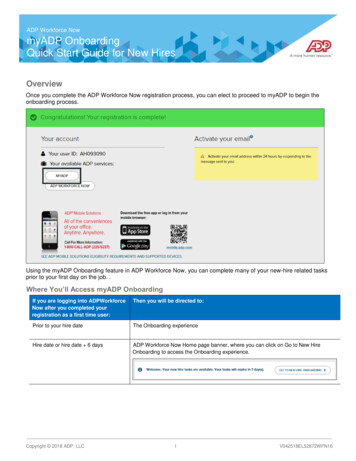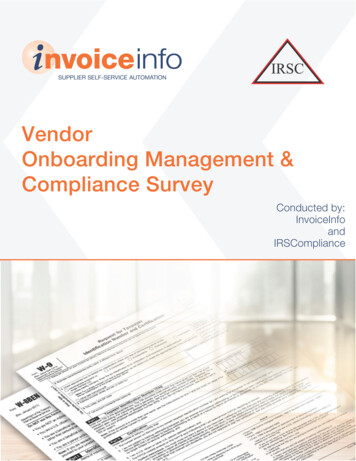
Transcription
WastePage 1
Table of ContentsTable of Contents . 2Introduction . 3Study Summary . 3What Department Handles Vendor Onboarding . 5Determination of the Payee’s Tax Status . 7Onboarding/W-9 Process for U.S. Payees . 8Onboarding Foreign Payees . 9New Supplier Information. 10Responsibility for Vendor Master File . 11Vendor TIN Match . 12Vendor OFAC Validation . 13Other Vendor Validation Tools . 14Length of Time to Onboard a New Vendor . 15Vendor Profile Changes . 16New Vendor Approval . 17Validating New Vendors . 20Compliance Training . 25Audits . 28Page 2
IntroductionVendor onboarding is a critical process at the early stages of a vendor relationship. Prior to onboardingthe vendor has spent time, in some cases much time, with others in the organization determining thesuitability of the vendor’s products or services. Onboarding is considered by the vendor, and often bythose in the organization who manage the vendor, as an administrative necessity to get the vendor inthe payables database to facilitate payment. In fact, IRS regulations and many U.S. states require thatU.S. organizations comply with these requirements to properly identify and document any payee priorto issuing any reportable payment to determine what – if any withholding taxes are required to beapplied to any such payments.There is much more to onboarding, though, than entering names and addresses into the vendor file.Assuring compliance with IRS regulations, Treasury Department regulations, data accuracy, corporatepayment and other initiatives should be addressed in the onboarding process to prevent omissions anderrors that create exception items downstream that are both expensive and increase the risk of being outof compliance. How this is handled affects the tone of the relationship with both the vendor and thevendor relationship manager. In addition, vendor onboarding processes including verification andcompliance have become boxes to be checked off by internal audit.Failure to implement and maintain a sound practice to properly document vendors/payees can result inIRS and state audits, penalties and financial liabilities for withholding taxes that were not applied anddeposited with the requiring tax agencies.InvoiceInfo and IRSCompliance surveyed 61organizations of all sizes and industries. The surveyreveals best practices, processes and insights into how organizations handle new vendoronboarding/registration and information reporting management and compliance.Study Summary When asked which department handles vendor onboarding/registration, the majority, who wereasked to select all that apply, said that AP is responsible (70%), 43% said purchasing handles and20% said other. The majority of participants have a policy in place to accurately identify the payee as a U.S. or aForeign entity (82%). In response to the question, “Which area determines the payee’s tax status,” 69% responded thataccounts payable handles it; 13% said that the tax department handles; 10% said purchasinghandles and 8% responded it is handled by the business area. When asked to describe the current process for onboarding a new U.S. vendor, the clear majority(69%) onboard new vendors manually and 77% onboard new foreign vendors manually. When asked what information is sent to new vendors, again asking them to check all, the mostpopular answer was W-8 and W-9 forms (67%), followed by new vendor forms (43%), welcomeletter (30%), “how to work” with us information (21%) and how to use the vendor self-serviceportal (13%). The majority of respondents indicate that accounts payable is responsible for the vendor masterfile (69%), 13% say purchasing is responsible and the remaining 18% said other. The IRS TIN Match program, available for the past decade, is now used by 61% of respondents tovalidate vendor tax ID numbers.Page 3
Meanwhile just 54% are checking their vendors against the OFAC SDN list. Fifty-seven percent of respondents reported that it takes between 10-30 minutes to onboard a newvendor. The majority of respondents (48%) spend less than 10 minutes on profile changes, while 35%spend 10-15 minutes, 12% spend 16-30 minutes and 5% spend more than 31 minutes. Most survey participant organizations require multiple levels of approval (54%) for onboardingnew vendors. For those that do require multiple levels, 52% require two levels, 30% require threelevels, 9% require four levels and 9% require more than four levels. The majority (67%) of survey respondents do not have an automated workflow process forapproving new vendors. For those that do, 65% have purchased software or a service, while 35%have developed an in-house solution. The majority of participants (63%) validate new vendors prior to purchasing from them. The majority of respondents (91%) require a completed W-9 or W-8 prior to payment. The majority of participants (61%) have a process in place to identify when Federal and Statewithholding is required on payments to be issued. When asked if their department has been pressured to improve the onboarding efficiency for bettercompliance with Federal and State regulations regarding payees and payments, 68% ofrespondents said no, with only 32% saying yes. Participants are trained primarily by attending webinars, with attending conferences coming insecond. Most of the respondents (41%) do not track more than the vendor’s state, such as where theservice is performed or where the rental property is located or where the money was earned, while32% do track and 27% were not certain. The majority of respondents (82%) have not been audited by the IRS for review of compliancewith respect to accurately documenting and validating payees. That means that nearly one in fiveparticipants have been audited.Page 4
What Department Handles Vendor OnboardingWhen survey participants were asked what department handles vendor onboarding in theirorganizations, 44% responded that dedicated onboarding staff in accounts payable handle it; 26%said that accounts payable processors are responsible; 23% said that dedicated onboarding staff withinpurchasing are responsible; 20% said that processors within purchasing handle onboarding; and 20%said other. Note that participants were asked to check all that apply so there is duplication in someinstances.What Department Handles Vendor %23.0%20.0%19.7%19.7%PurchasingProcessorsOnboard VendorsOther15.0%10.0%5.0%0.0%Accounts Payable Accounts rding Staff Onboard Vendors Onboarding StaffPage 5
Of those that replied “Other,” here are some of the responses: Compliance department A data management group that establishes all vendors and customers Vendor master department Treasury operations Vendor management specialist Sourcing Accountant Master data management Separate team to AP, AR and purchasing Separate supplier governance department AR and AP setup separate from both and purchasing Master data governance, under P2P organization Operations and engineering participate in vendor discovery and selectionPage 6
Determination of the Payee’s Tax StatusWhen onboarding a vendor, the majority of the survey respondents said that they have a process inplace to accurately identify the payee as a U.S. or Foreign individual or corporation (82%).In response to the question, “Which area determines the payee’s tax status,” 69% responded thataccounts payable handles it; 13% said that the tax department handles; 10% said purchasing handlesand 8% responded it is handled by a business area.Does AP Have a Process in Place to Accurately Identify thePayee as a U.S. or Foreign Individual or 0%11.5%10.0%6.6%0.0%Yes - we follow apolicy on collectingand validating proofof citizenship andtax status suchas individual,business entity ora U.S. corporation.80.0%70.0%Yes - we determinethe tax status ofthe payee basedon payee addressand type of payment.No - the validationand proof process isperformed elsewherein our organization.No - I am not sureof the process thatmay be used toidentify and validatethe U.S. or Foreignstatus of a payee.Who Determines the Payee's Tax %8.2%PurchasingBusiness Area0.0%Accounts PayablePage 7Tax Department
Onboarding/W-9 Process for U.S. PayeesWhen asked to describe the current process for onboarding a new U.S. vendor, the majority of therespondents (69%) said that they have a manual process; 11% have an automated process, 18% haveboth manual and automated and 2% said other.What is Your CurrentOnboarding/W-9 Process for a U.S. %11.5%10.0%1.6%0.0%Manual processPage 8AutomatedBoth manualand automatedOther
Onboarding Foreign PayeesParticipants were asked to describe how they currently onboard and handle W-8s for foreign payees.Similar to U.S. payees, the clear majority of respondents (77%) have a manual process, followed byboth a manual and automated processes at 11%; an only automated process (5%) and 7% said other.90.0%80.0%What is Your CurrentOnboarding/W-8 Process for a Foreign %6.6%Both manualand automatedOther4.9%0.0%Manual processAutomatedFor those that replied “Other,” those companies do not have foreign vendors.Page 9
New Supplier InformationWhen asked what information is sent to new vendors, W-8 and W-9 forms was the most popularanswer at 67%, followed by a new vendor form (43%), welcome letter (30%), “how to work” with usinformation (21%), how to use your vendor self-service portal (13%) and other (15%).What Information do You Send Your New .5%21.3%20.0%13.1%14.8%10.0%0.0%Welcomeletter"How to work" W-8 / W-9 formswith usinformationNewvendor formFor those participants who said other, here are some of their responses: Nothing is sent to the vendor Banking information request for ACH payments List of requirements and terms Minority owned business formPage 10How to useyour vendorself-serviceportalOther
Responsibility for Vendor Master FileAccounts payable best practice dictates that accounts payable should be responsible for the vendormaster file, and according to the survey results the majority (69%) of the participants are doing justthat. Purchasing is responsible in 13% of participating organizations and 18% said other.Which Department is Responsible for YourVendor Master File %20.0%13.1%10.0%0.0%Accounts PayablePurchasingFor those who replied “other,” some of the results follow: Finance, accounting or treasury operations Master data management group (separate from AP, AR purchasing) Strategic sourcing Supplier governancePage 11Other
Vendor TIN Match ValidationWhen asked if new vendors are validated against the IRS TIN match system, 61% said yes, 32% saidno and another 7% said they did not know.Do You Validate New VendorsAgainst the IRS TIN Match 0%6.8%0.0%YesPage 12NoDon't know
Vendor OFAC ValidationWhen participants were asked if they validate new vendors against the Office of Foreign Controls(OFAC) list, 54% responded yes, 39% said no and 7% said they did not know.Do You Validate New Vendors Against the OFAC .0%YesPage 13NoDon't know
Other Vendor Validation ToolsParticipants were asked to describe all the tools they use to validate vendors other than TIN Match andOFAC validation. Of those that responded, 46% use Dun & Bradstreet, 8% use Equifax, 3% useExperian, 27% use none and 30% said other.Vendor Validation 5.0%20.0%15.0%10.0%8.1%5.0%2.7%0.0%Dun & BradstreetEquifaxExperianNoneOf those that responded other, here are some of their responses: GST Registry In-house assessment by master team No validation process is followed except the checking of bank details with the vendor Not done by AP SAM Streamline Verify Third party Thomson Reuters TIN CheckPage 14Other
Length of Time to Onboard a New VendorWhen asked how much time is spent onboarding a new vendor, the majority (57%) said it takesbetween 10-30 minutes, 17% said it takes less than 10 minutes, 16% said it takes between 31-60minutes and 10% said it takes more than one hour.How Much Time is Spent Onboarding a New 0%10.0%10.0%6.7%5.0%0.0%Less than10 minutesPage More thanone hour
Vendor Profile ChangesWhen asked how many vendor profile changes are processed each month, 32% responded 20 or less,23% said 21-50, 20% said 101-200, 13% from 51-100, 20% from 101-200, and 12% process more than201 vendor profile changes each month.35.0%How Many Vendor Profile ChangesDo You Make Each %3.3%3.3%5.0%201-500501-1,000Morethan 1,0005.0%0.0%20or less21-5051-100101-200The majority of respondents (48%) spend less than 10 minutes on profile changes, 35% spend 10-15minutes, 12% from 16-30 minutes and 5% spend more than 31 minutes.How Much Time is SpentMaking Each Vendor Profile 0%3.3%1.7%0.0%Less than10 minutesPage More thanone hour
New Vendor ApprovalMost participants require multiple levels of approval (54%) for onboarding new vendors, while 43% donot.Do You Have Multiple Levels of Approvalfor Onboarding New 3%0.0%YesNoDon't knowFor those organizations that do require multiple levels, 52% require two levels, 30% require threelevels, 9% require four levels and 9% require more than four levels.How Many Levels of Approval forOnboarding New Vendors Do You .1%4More than 40.0%2Page 173
The majority (67%) does not have an automated workflow process for approving new vendors. But forthose that do have an automated process (33%), 35% have developed an in-house solution to handlethis, while the majority (65%) has purchased software or a service.80.0%Do You Use an AutomatedWorkflow Process for Approving New .0%0.0%YesNoWhat Type of an Automated Workflow Process forApproving New Vendors Do You .0%Developed in-housePage 18Purchased software or service
When asked how many new vendors are onboarded monthly, 28% said 20 or less, 30% said 21-50,21% said 51-200, 12% said 101-200 and 9% process more than 200 new vendors.On Average, How ManyNew Vendors Do You Onboard .3%10.0%5.3%5.0%1.8%1.8%501-1,000Morethan 1,0000.0%20or lessPage 1921-5051-100101-200201-500
Validating New VendorsThe majority of participants (63%) validate new vendors prior to purchasing from them.Does the Purchasing Department Validate New VendorsPrior to Purchasing from 0.0%YesNoThe clear majority of respondents (91%) requires a completed W-8 or W-9 prior to payment andclearly understands how difficult it is to stay compliant after the vendor has already been paid.Does Accounts Payable or Tax Require a CompletedW-8 or W-9 Form Prior to 0.0%20.0%8.8%10.0%0.0%YesPage 20No
The clear majority (88%) does not use an automated supplier self-service solution to onboardnew vendors.Do You Use a Supplier Self-ServiceSolution to Onboard New 0.0%20.0%10.0%12.3%0.0%YesPage 21No
The good news is that the majority of participants (61%) have a process in place to identify whenFederal and State withholding is required on payments to be issued, 21% do not have a process in placeand 18% do not know if they do.Does Your Organization Have a Process in Place toIdentify When Federal and State Withholding isRequired on Payments to be 9%10.0%0.0%YesPage 22NoNot certain
When asked if their organization was fluent with the information collection and review required forU.S. and foreign payees, and the requirements of OFAC and the IRS and individual states in order toreport and apply correctly, only 52% said yes, while 21% said no and 27% were uncertain.Is Your Organization Fluent with the Information Collectionand Review Required for U.S. and Foreign Payees, and with theRequirements of OFAC, and the IRS and Individual States in Orderto Properly Report and Apply Withholding on 0.0%0.0%YesPage 23NoNot certain
While the IRS is increasing fines and penalties for improper filings, it does not seem to be affectingorganizations desire to spend the time and money to comply. According to the survey, when asked iftheir department has been pressured to improve the onboarding efficiency for better compliance withFederal and State regulations regarding payees and payments, 68% of respondents said no, with only32% saying yes.Has Your Department Been Pressured toImprove the Onboarding Efficiency for BetterCompliance with Federal and StateRegulations Regarding Payees and 0.0%10.0%0.0%YesPage 24No
Compliance TrainingWhen it comes to training employees to ensure they keep up with new IRS, OFAC and other federaland state regulations regarding vendors, 66% of survey participants said they attend webinars, 22%attend the IRSCompliance conference, 32% attend AP conferences and 36% said other.What Training Does Your Team Get to Ensure They KeepUp With New IRS, OFAC and Other Federal and StateRegulations Regarding .0%20.0%10.0%0.0%Attend webinarsAttend IRSCompliance Attend AP conferencesconferenceOf those that responded other, here are some of the ways they train their team: Corporate tax group provides training Counter fraud guidance Websites, emails with updates Handled by data management team IFRS, IPAS In-house training Internet Literature Outside CPA training and consultation Not much training; usually self-taughtPage 25Other
Several organizations, including IRSCompliance, offer professional certifications to ensure that anemployee has a complete understanding of information reporting. Only 30% of survey respondents arecertified; 70% are not.Has Anyone in Your OrganizationBecome Certified as Having a .0%10.0%0.0%YesNoWhen asked if their organization’s process tracks the state to which the payment will apply, other thanthe state of the vendor, for example, where the service was performed or where the rental property islocated or where the money was earned, only 32% answered yes, 41% answered no and 27% were notcertain.Does Your Process Track the State to Which the PaymentWill Apply — Other Than the Resident State of the 0%15.0%10.0%5.0%0.0%YesPage 26NoNot certain
The reporting due dates to report to the IRS, SSA and states for non-employee compensation (box 7)reporting on Form 1099-MISC and Form W-2 have changed to January 31. When asked how this hasimpacted onboarding and certification of payees and payment reconciliation, 14% responded that it hassignificantly affected them, 25% responded that it had a somewhat affect, 30.5% were able to complyeasily and 30.5% said it did not impact their area.Have the New Reporting Due Dates of January 31stto the IRS, SSA and States for Non-Employee Compensation(Box 7) Reporting on Form 1099-Misc and FormW-2 Impacted Your Onboarding and Certificationof Payees and Payment Reconciliation?35.0%30.0%30.4%30.4%No - we wereable to comply easilyNo - this didnot impact our area25.0%25.0%20.0%15.0%14.3%10.0%5.0%0.0%Yes - significantlyPage 27Yes - somewhat
AuditsLet’s face it, when it comes to information reporting, compliance is complex and difficult tounderstand. Many AP professionals are concerned about errors being made and penalties beingassessed. And, the worst possible outcome is an IRS audit. The good news according to the survey isthat the majority of respondents (81%) have not been audited by the IRS for review of compliance withrespect to accurately documenting and validating payees.90.0%Has Your Department Ever Been Audited by the IRS for aReview of Compliance with Respect to AccuratelyDocumenting and Validating 5%10.0%0.0%YesPage 28No
Page 29
Vendor onboarding is a critical process at the early stages of a vendor relationship. Prior to onboarding the vendor has spent time, in some cases much time, with others in the organization determining the suitability of the vendor's products or services. Onboarding is considered by the vendor, and often by

